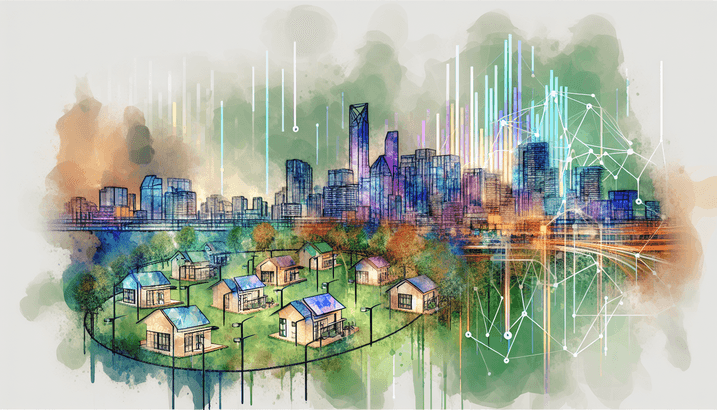Sustainable Building Practices: 7 Revolutionary Tips for a Greener Future
1. Understanding Sustainable Building
Do you know why sustainable building is becoming essential in today’s world? Environmental concerns and the need for better resource management are driving many to rethink their construction practices.
Sustainable building practices refer to creating structures using processes that are environmentally responsible and resource-efficient throughout a building’s life cycle: from siting to design, construction, operation, maintenance, renovation, and demolition.
Understanding these practices is crucial for anyone looking to minimize environmental impact and maximize efficiency. The key is to balance present needs without compromising the ability of future generations to meet theirs.
Essentially, it involves using various strategies to reduce energy consumption, limit waste, and maintain indoor environmental quality. Are you prepared to dive deeper into the world of green construction? For more insights, check out our sustainability section.
2. Incorporating Renewable Energy Solutions
Why is it important to use renewable energy in construction? Let’s find out.
Renewable energy solutions, like solar panels and wind turbines, are becoming integral to sustainable buildings. These systems not only reduce dependency on fossil fuels but also lower long-term energy costs.
Let’s explore solar energy. Solar panels can be installed on rooftops to generate electricity or heat water for domestic use. The initial investment might be steep, but the returns in terms of energy savings are significant.
Ever considered wind energy? Small wind turbines can be integrated into building designs, particularly in areas with consistent wind patterns. They efficiently convert wind energy into electricity, providing another layer of energy independence.
Are you looking at other options? Geothermal systems are worth considering. They use the earth’s consistent underground temperature to heat and cool homes, offering a sustainable and reliable energy source. For more innovative energy solutions, click here.
3. Utilizing Recycled and Eco-friendly Materials
Do you know why recycled materials are gaining traction in construction?
Utilizing recycled and eco-friendly materials can significantly reduce the carbon footprint of a building project. Materials like recycled steel, reclaimed wood, and bamboo not only lessen the environmental impact but also contribute to a unique and aesthetic appeal.
For instance, recycled steel is durable, versatile, and has a smaller carbon footprint compared to traditional steel. Similarly, reclaimed wood offers both a rustic look and sustainability, as it reduces the need for new timber.
What about innovative materials? Hempcrete, made from hemp fibers and lime, is a carbon-negative material that provides excellent insulation and durability. It’s both strong and sustainable!
Are there alternatives to concrete? Indeed! Green concrete, which uses waste materials such as fly ash or slag, reduces the overall carbon emissions related to concrete production.
Incorporating these materials not only contributes to a greener environment but also fosters innovation in building designs. Ready to make a choice for the better? Discover more in our construction development section.
4. Embracing Energy-efficient Systems
Why is investing in energy-efficient systems key to sustainable building?
Investing in energy-efficient systems is crucial as it drastically reduces the energy required to operate buildings. These systems are designed to minimize energy use while maintaining comfort and functionality.
Efficient lighting is a place to start. LED lights consume far less electricity and have a longer lifespan compared to traditional bulbs. With advancements in technology, LEDs can now be customized for different settings and moods.
Have you heard about smart thermostats? These devices intelligently regulate heating and cooling, ensuring that energy is not wasted. They can be programmed to adjust temperatures based on occupancy, time of day, and even weather conditions.
What about insulation? Proper insulation is fundamental in reducing heating and cooling loads. Materials like cellulose, fiberglass, and spray foam offer excellent thermal resistance, keeping homes comfortable and energy bills low. For more on efficient building systems, visit our real estate services page.
5. Water Conservation Strategies
Why is water conservation a critical part of sustainable building? Let’s delve into it.
Water conservation strategies are essential to sustainable building as they ensure resources are used efficiently and responsibly.
Rainwater harvesting is a great starting point. This system collects and stores rainwater for various uses, such as irrigation and flushing toilets. This not only saves water but also reduces the demand on municipal water supplies.
Have you considered low-flow fixtures? Installing low-flow showerheads, faucets, and toilets can significantly reduce water consumption. These fixtures maintain performance while using less water.
What about greywater systems? Greywater recycling involves reusing water from sinks, showers, and laundry for non-potable purposes like landscaping. This practice not only conserves water but also reduces wastewater treatment loads.
Another effective strategy involves using drought-resistant plants in landscaping. These plants require less water and maintenance, promoting a sustainable and aesthetically pleasing environment.
6. Integrating Green Spaces and Biodiversity
Do you know the benefits of integrating green spaces in sustainable building? Let’s explore.
Integrating green spaces and biodiversity within building projects enhances both the environment and the well-being of occupants.
One approach is the creation of green roofs and walls. These installations provide insulation, reduce urban heat island effects, and improve air quality. Additionally, they create habitats for birds, insects, and other wildlife.
Have you thought about urban gardens? Urban gardens offer residents opportunities to grow their own food, promoting self-sufficiency and reducing the carbon footprint associated with transporting produce.
Another innovative idea is creating multifunctional landscapes that combine recreational spaces with ecological functions. Such areas can act as stormwater management systems while providing areas for relaxation and community activities.
Incorporating green spaces also contributes to mental well-being. Studies show that access to nature and greenery boosts mood, reduces stress, and improves overall health. Learn more about how integrating green spaces can benefit your projects by visiting our architecture section.
7. Commitment to a Greener Future
Why is a commitment to sustainability essential in building practices?
Commitment to a greener future is not just a trend; it’s a responsible choice towards ensuring a sustainable planet. Building practices must evolve to meet the rising environmental challenges.
This commitment involves staying informed on the latest sustainable technologies and practices. Continuous learning and adaptation are key to keeping buildings energy-efficient and environmentally friendly.
What role do certifications play? Certifications like LEED and BREEAM provide frameworks and standards for creating sustainable buildings. These certifications ensure that buildings meet high sustainability criteria.
Engaging stakeholders, from owners to occupants, in sustainability efforts is equally critical. When everyone is involved and aware, the impact is much more significant. Are you ready to make a lasting difference? For more on the latest in real estate news and trends, click here.
In conclusion, adopting sustainable building practices requires understanding and implementing various innovative strategies. From renewable energy solutions to water conservation, each approach contributes to minimizing the environmental footprint and enhancing the quality of life. Are you prepared to embrace these revolutionary tips for a greener future? For more insights, visit this link.




